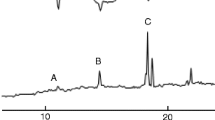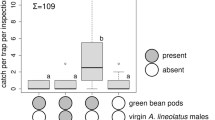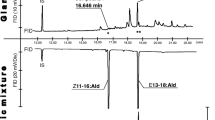Abstract
Coupled gas chromatographic (GC)–electroantennographic detection (EAD) analyses of ovipositor extract of calling Hessian fly, Mayetiola destructor, females revealed that seven compounds elicited responses from male antennae. Four of the compounds—(2S)-tridec-2-yl acetate, (2S,10Z)-10-tridecen-2-yl acetate, (2S,10E)-10-tridecen-2-yl acetate, and (2S,10E)-10-tridecen-2-ol—were identified previously in female extracts. Two new EAD-active compounds, (2S,8Z,10E)-8,10-tridecadien-2-yl acetate and (2S,8E,10E)-8,10-tridecadien-2-yl acetate, were identified by GC–mass spectroscopy (MS) and the use of synthetic reference samples. In a Y-tube bioassay, a five-component blend (1 ng (2S)-tridec-2-yl acetate, 10 ng (2S,10E)-10-tridecen-2-yl acetate, 1 ng (2S,10E)-10-tridecen-2-ol, 1 ng (2S,8Z,10E)-8,10-tridecadien-2-yl acetate, and 1 ng (2S,8E,10E)-8,10-tridecadien-2-yl acetate) was as attractive to male Hessian flies as a similar amount of female extract (with respect to the main compound, (2S,10E)-10-tridecen-2-yl acetate). The five-component blend was more attractive to male flies than a three-component blend lacking the two dienes. Furthermore, the five-component blend was more attractive than a blend with the same compounds but that contained one tenth the concentration of (2S,8E,10E)-8,10-tridecadien-2-yl acetate (more accurately mimicking the ratios found in female extract). This suggests that the ratios emitted by females might deviate from those in gland extracts. In a field-trapping experiment, the five-component blend applied to polyethylene cap dispensers in a 100:10 μg ratio between the main component and each of the other blend components attracted a significant number of male Hessian flies. Also, a small-plot field test demonstrated the attractiveness of the five-component blend to male Hessian flies and suggests that this pheromone blend may be useful for monitoring and predicting Hessian fly outbreaks in agricultural systems.







Similar content being viewed by others
References
Arn, H., Städler, E., and Rauscher, S. 1975. The electroantennographic detector—a selective tool in the gas chromatographic analysis of insect pheromones. Z. Naturforsch. 30c:722–725.
Barnes, H. F. 1956. Gall Midges of Economic Importance, Vol. VII, Gall midges of cereal crops. Crosby Lockwood, London.
Bergh, J. C., Harris, M. O., and Rose, S. 1990. Temporal patterns of emergence and reproductive behavior of the Hessian fly (Diptera: Cecidomyiidae). Ann. Entomol. Soc. Am. 83:998–1004.
Berzonsky, W. A., Ding, H., Haley, S. D., Harris, M. O., Lamb, R. J., McKenzie, R. I. H., Ohm, H. W., Patterson, F. L., Peairs, F. B., Porter, D. R., Ratcliffe, R. H., and Shanower, T. G. 2003. Breeding wheat for resistance to insects. Plant Breed. Rev. 22:221–296.
Buntin, G. D., Bruckner, P. L., and Johnson, J. W. 1990. Management of Hessian fly (Diptera: Cecidomyiidae) in Georgia by delayed planting of winter wheat. J. Econ. Entomol. 83:1025–1033.
Buntin, G. D., Ott, S. L., and Johnson, J. W. 1992. Integration of plant resistance, insecticides, and planting date for management of the Hessian fly (Diptera: Cecidomyiidae) in winter wheat. J. Econ. Entomol. 85:530–538.
Choi, M.-Y., Khaskin, G., Gries, R., Gries, G., Roitberg, B. D., Raworth, D. A., Kim, D.-H., and Bennett, R. G. 2004. (2R,7S)-diacetoxytridecane: sex pheromone of the aphidophagous gall midge, Aphidoletes aphidimyza. J. Chem. Ecol. 30:659–670.
Cox, T. S., and Hatchett, J. H. 1986. Genetic model for wheat/Hessian fly (Diptera: Cecidomyiidae) interaction: strategies for deployment of resistance genes in wheat cultivars. Environ. Entomol. 15:24–31.
El Bouhssini, M., Nsarellah, M. N., Nachit, M. M., Bentika, A., Benlahbib, O., and Lhaloui, S. 1999. First source of resistance in durum wheat to Hessian fly (Diptera: Cecidomyiidae) in Morocco. Genet. Resour. Crop Evol. 46:107–109.
Foster, S. P., Bergh, J. C., Rose, S., and Harris, M. O. 1991a. Aspects of pheromone biosynthesis in the Hessian fly, Mayetiola destructor (Say). J. Insect Physiol. 37:899–906.
Foster, S. P., Harris, M. O., and Millar, J. G. 1991b. Identification of the sex pheromone of the Hessian fly, Mayetiola destructor (Say). Naturwiss. 78:130–131.
Fouquet, G., and Schlosser, M. 1974. Improved carbon-carbon linking by controlled copper catalysis. Angew. Chem. Intern. Ed. 13:82–83.
Gagné, R. J. 1989. The Plant-feeding Gall Midges of North America. Cornell University Press, Ithaca.
Gries, R., Gries, G., Khaskin, G., King, S., Olfert, O., Kaminski, L.-A., Lamb, R., and Bennett, R. 2000. Sex pheromone of orange wheat blossom midge, Sitodiplosis mosellana. Naturwiss. 87:450–454.
Gries, R., Khaskin, G., Gries, G., Bennett, R. G., King, G. G. S., Morewood, P., Slessor, K. N., and Morewood, W. D. 2002. (Z,Z)-4,7-tridecadien-(S)-2-yl acetate: sex pheromone of Douglas-fir cone gall midge, Contarinia oregonensis. J. Chem. Ecol. 28:2283–2297.
Gries, R., Khaskin, G., Bennett, R. G., Miroshnychenko, A., Burden, K., and Gries, G. 2005. (S,S)-2,12-, (S,S)-2,13-, and (S,S)-2,14-diacetoxyheptadecanes: sex pheromone components of red cedar cone midge, Mayetiola thujae. J. Chem. Ecol. 31:2933–2946.
Harris, M. O., and Foster, S. P. 1991. Wind tunnel studies of sex pheromone-mediated behavior of the Hessian fly (Diptera: Cecidomyiidae). J. Chem. Ecol. 17:2421–2435.
Harris, M. O., and Foster, S. P. 1999. Gall midges, pp. 27–49, in J. Hardie, and A. K. Minks (eds.). Pheromones of Non-Lepidopteran Insects Associated with Agricultural Plants. CAB International, Oxford, UK.
Harris, M. O., Stuart, J. J., Mohan, M., Nair, S., Lamb, R. J., and Rohfritsch, O. 2003. Grasses and gall midges: plant defense and insect adaptation. Annu. Rev. Entomol. 48:549–577.
Hillbur, Y., Anderson, P., Arn, H., Bengtsson, M., Löfqvist, J., Biddle, A. J., Smitt, O., Högberg, H.-E., Plass, E., Franke, S., and Francke, W. 1999. Identification of sex pheromone components of the pea midge, Contarinia pisi (Diptera: Cecidomyiidae). Naturwiss. 86:292–294.
Hillbur, Y., El-Sayed, A., Bengtsson, M., Löfqvist, J., Biddle, A., Plass, E., and Francke, W. 2000. Laboratory and field study of the attraction of male pea midges, Contarinia pisi, to synthetic sex pheromone components. J. Chem. Ecol. 26:1941–1952.
Hillbur, Y., Bengtsson, M., Löfqvist, J., Biddle, A., Pillon, O., Plass, E., Francke, W., and Hallberg, E. 2001. A chiral sex pheromone system in the pea midge, Contarinia pisi. J. Chem. Ecol. 27:1391–1407.
Hillbur, Y., Celander, M., Baur, R., Rausher, S., Haftmann, J., Franke, S., and Francke, W. 2005. Identification of the sex pheromone of the swede midge, Contarinia nasturtii. J. Chem. Ecol. 31:1807–1828.
Horner, L., Oediger, H., and Hoffmann, H. 1959. Reaktionen mit Triphenylphosphan-dihalogeniden. Liebigs Ann. Chem. 626:26–34.
Ikan, R. 1982. Chromatography in Organic Microanalysis. Academic, New York.
Jönsson, M., Lindkvist, A., and Anderson, P. 2005. Behavioral responses in three ichneumonid pollen beetle parasitoids to volatiles emitted from different phenological stages of oilseed rape. Entomol. Exp. Appl. 115:363–369.
Linn, C. E. Jr., and Roelofs, W. L. 1995. Pheromone communication in moths and its role in the speciation process, pp. 263–300, in D. M. Lambert, and H. G. Spencer (eds.). Speciation and the Recognition Concept: Theory and Application. Johns Hopkins University Press, Baltimore.
Löfstedt, C., and Odham, G. 1984. Analysis of moth pheromone acetates by selected ion monitoring using electron impact and chemical ionization mass spectrometry. Biomed. Mass Spectrom. 11:106–113.
McKay, P. A., and Hatchett, J. H. 1984. Mating behavior and evidence of a female sex pheromone in the Hessian fly, Mayetiola destructor (Say) (Diptera: Cecidomyiidae). Ann. Entomol. Soc. Am. 77:616–620.
Millar, J. G., Foster, S. P., and Harris, M. O. 1991. Synthesis of the stereoisomers of the female sex pheromone of the Hessian fly, Mayetiola destructor. J. Chem. Ecol. 17:2437–2447.
Rausher, M. D. 2001. Co-evolution and plant resistance to natural enemies. Nature. 411:857–864.
Rossi, R., and Carpita, A. 1977. Insect pheromones: Stereoselective reduction of β- or ω-alkynols to the corresponding (E)-alkenols by lithium tetrahydroaluminate. Synthesis 8:561–562.
Samain, D., Decoins, C., and Langlois, Y. 1978. Stéréochimie de l’alkylation des acétates diéniques conjugées en 2.4 par les organo-magnésiens en présence de sels de cuivre. Nouveau J. Chim. 2:249–254.
Solinas, M., and Isidoro, N. 1996. Functional anatomy of female sex pheromone gland of Mayetiola destructor Say (Diptera: Cecidomyiidae). Entomologica (Bari) 30:43–54.
Wall, C., Biddle, A. J., Blood Smyth, J., Foot, G. E., Garthwaite, D. G., Morris, N., Owen, C. R., Sturgeon, D. M., and Weyman, G. 1991. Local spatial and temporal distribution of pea midge, Contarinia pisi. Asp. Appl. Biol. 27:355–360.
Wiley, G. A., Hershkowitz, R. L., Rein, B. M., and Chung, B. C. 1964. Studies in organophosphorus chemistry I. Conversion of alcohols and phenols to halides by tertiary phosphine dihalides. J. Am. Chem. Soc. 86:964–965.
Yadav, J. S., Chandrasekhar, S., and Kache, R. 1995. Short and stereoselective syntheses of pheromone components of Aproaerema modicella. Synth. Commun. 25:4035–4043.
Acknowledgements
We thank Thiago Benatti and Rajat Aggarwal (Dept. Entomology, Purdue University, West Lafayette, IN, USA) for insect rearing. We also thank Elin Isberg for assistance in rearing and Y-tube bioassays. Many thanks also to Gary Cramer (Sedgwick County Extension, Wichita, KS, USA) for field assistance and Ray Gagné (Dept. Entomology, Smithsonian Institute, Washington, DC, USA) for the identification of insects. This study was partly funded by USDA-NRI, grant #2004-03099 (J. J. Stuart) and by the Royal Swedish Academy of Agriculture and Forestry, grant FS-234 (M. N. Andersson). W. Francke acknowledges the support of the Fonds der Chemischen Industrie.
Author information
Authors and Affiliations
Corresponding author
Rights and permissions
About this article
Cite this article
Andersson, M.N., Haftmann, J., Stuart, J.J. et al. Identification of Sex Pheromone Components of the Hessian Fly, Mayetiola destructor . J Chem Ecol 35, 81–95 (2009). https://doi.org/10.1007/s10886-008-9569-1
Received:
Revised:
Accepted:
Published:
Issue Date:
DOI: https://doi.org/10.1007/s10886-008-9569-1




